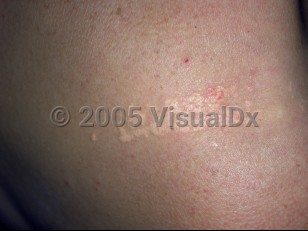Primary biliary cholangitis
Alerts and Notices
Important News & Links
Synopsis

Primary biliary cholangitis (PBC), formerly referred to as primary biliary cirrhosis, is a chronic liver disease characterized by intralobular bile ducts that are progressively injured by chronic inflammation, leading to cirrhosis and end-stage liver disease.
PBC affects primarily women (approximately 90% of cases) and is diagnosed most commonly in the third to sixth decade of life. Its incidence is highest in the North American and European populations.
Presenting symptoms are subtle, with fatigue and pruritus being the primary complaints. Approximately 50% of patients are asymptomatic at the time of diagnosis, with PBC diagnosed on the basis of incidentally detected elevations in liver function tests. As the disease progresses, hepatomegaly, ascites, and jaundice can develop as manifestations of cirrhosis and advanced liver disease.
Common laboratory findings include elevated alkaline phosphatase (ALP), hyperbilirubinemia, and positive antimitochondrial antibodies (AMA). Portal or portopulmonary hypertension may be present. In a variant form termed autoimmune cholangitis, patients have identical clinical and pathological features but are antinuclear antibody (ANA)-positive rather than AMA-positive. In severe cases, hepatocytes generate an atypical lipoprotein (lipoprotein X), which forms complexes with lipids leading to high total cholesterol, low-density lipoproteins (LDL), and triglycerides.
The disease is slowly progressive, and some patients may remain asymptomatic for years after diagnosis. Five years from diagnosis, approximately 50% of patients will have disease progression characterized by elevated bilirubin and low albumin.
PBC may be associated with autoimmune diseases such as morphea, dermatomyositis, lichen planus, and vitiligo.
Palmar xanthomas and xanthelasma, and more rarely other types of xanthoma, may also occur in the setting of secondary dyslipidemia.
Cutaneous fungal infections are more common in patients with PBC. These may present as onychomycosis, tinea pedis, and tinea manuum.
PBC affects primarily women (approximately 90% of cases) and is diagnosed most commonly in the third to sixth decade of life. Its incidence is highest in the North American and European populations.
Presenting symptoms are subtle, with fatigue and pruritus being the primary complaints. Approximately 50% of patients are asymptomatic at the time of diagnosis, with PBC diagnosed on the basis of incidentally detected elevations in liver function tests. As the disease progresses, hepatomegaly, ascites, and jaundice can develop as manifestations of cirrhosis and advanced liver disease.
Common laboratory findings include elevated alkaline phosphatase (ALP), hyperbilirubinemia, and positive antimitochondrial antibodies (AMA). Portal or portopulmonary hypertension may be present. In a variant form termed autoimmune cholangitis, patients have identical clinical and pathological features but are antinuclear antibody (ANA)-positive rather than AMA-positive. In severe cases, hepatocytes generate an atypical lipoprotein (lipoprotein X), which forms complexes with lipids leading to high total cholesterol, low-density lipoproteins (LDL), and triglycerides.
The disease is slowly progressive, and some patients may remain asymptomatic for years after diagnosis. Five years from diagnosis, approximately 50% of patients will have disease progression characterized by elevated bilirubin and low albumin.
PBC may be associated with autoimmune diseases such as morphea, dermatomyositis, lichen planus, and vitiligo.
Palmar xanthomas and xanthelasma, and more rarely other types of xanthoma, may also occur in the setting of secondary dyslipidemia.
Cutaneous fungal infections are more common in patients with PBC. These may present as onychomycosis, tinea pedis, and tinea manuum.
Codes
ICD10CM:
K74.3 – Primary biliary cirrhosis
SNOMEDCT:
31712002 – Primary biliary cholangitis
K74.3 – Primary biliary cirrhosis
SNOMEDCT:
31712002 – Primary biliary cholangitis
Look For
Subscription Required
Diagnostic Pearls
Subscription Required
Differential Diagnosis & Pitfalls

To perform a comparison, select diagnoses from the classic differential
Subscription Required
Best Tests
Subscription Required
Management Pearls
Subscription Required
Therapy
Subscription Required
References
Subscription Required
Last Reviewed:11/18/2021
Last Updated:03/08/2023
Last Updated:03/08/2023

